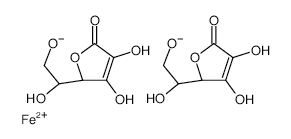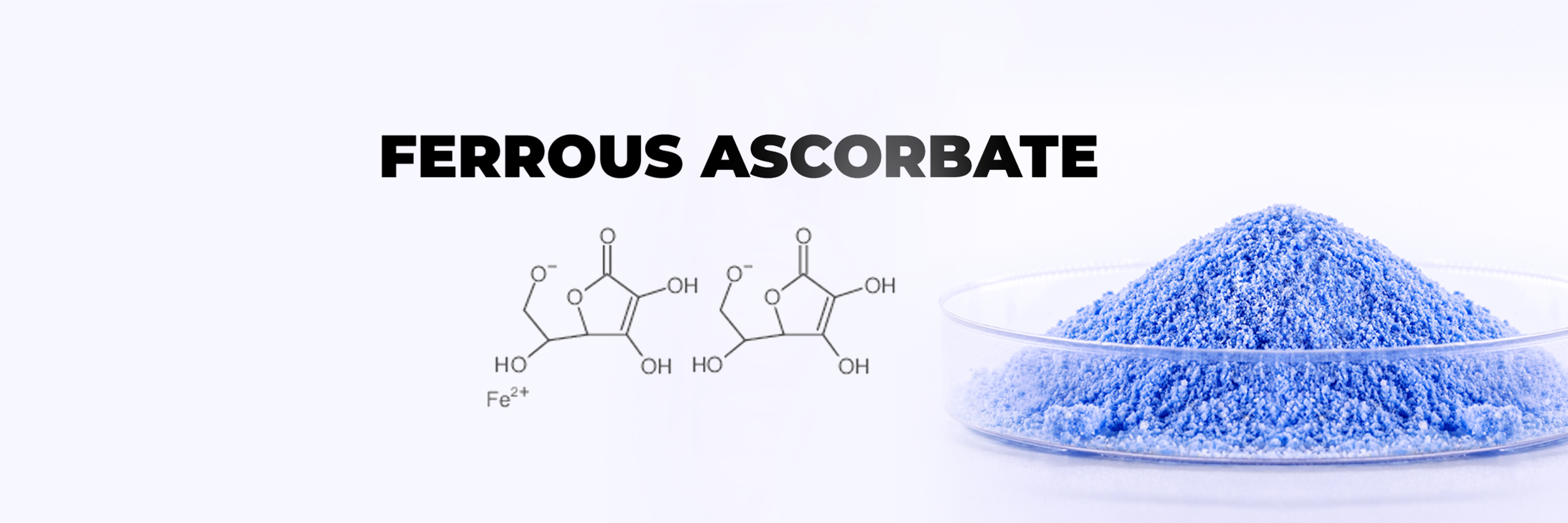INTRODUCTION
Ferrous Ascorbate is a combination of vitamin C and iron. Ferrum or iron helps to replenish the iron stores in the human body. Ascorbate contains vitamin C that improves iron levels in the body by increasing its absorption from different sources.
Manufacture
By reacting alkali or alkaline earth metals with ferrous sulfate, the corresponding ferrous salts are formed, which are then reacted with ascorbic acid in slightly acidic or neutral conditions in an aqueous medium. To obtain ferrous ascorbate, the mother liquor must be filtered.
| Synonyms | Ascorbic acid ferrous salt Vitamin C iron(II) salt L-(+)-Ascorbic acid iron(II) salt |
| CAS no. | 24808-52-4 |
| EINECS no. | 246-469-7 |
| Molecular formula | C12H16FeO12 |
| Molecular weight | 406.08 |
| Structure |  |
APPLICATIONS
Ferrous Ascorbate has several applications in the pharmaceutical industry and is a valuable component in many medications and supplements.
| Iron supplement | It is commonly used as an iron supplement in the pharmaceutical industry to treat iron-deficiency anemia. It is available in various forms such as tablets, capsules, and syrups. |
| Nutraceutical | It is also used as a nutraceutical, which is a dietary supplement that provides health benefits beyond basic nutrition. It is often used in combination with other vitamins and minerals to promote overall health and wellness. |
| Antioxidant | Ascorbate, the other component of Ferrous ascorbate, is a powerful antioxidant. Antioxidants help to neutralize harmful free radicals in the body, which can cause damage to cells and contribute to the development of various diseases. |
| Anti-inflammatory | Ascorbate also has anti-inflammatory properties and can help to reduce inflammation in the body. This makes it useful in the treatment of conditions such as arthritis and other inflammatory disorders. |
| Immune system support | Ascorbate is also essential for the proper functioning of the immune system. It plays a vital role in the production of white blood cells and helps to protect the body against infections and diseases. |
SPECIFICATIONS
| Test | Unit | Specification |
|---|---|---|
| Appearance | – | A dark violet colored powder |
| Solubility | – | Freely soluble in wáter |
| Identification A. Iron test B. Ascorbic test | – – | The solution will give blue colour A grey precipitate is formed |
| Loss on Drying | % | ≤ 10 |
| Heavy metals | ppm | ≤ 25 |
| pH (aq. solution) | % w/v | 1.0 |
| Assay (ODB) 1. Content of Iron 2. Content of Ascorbic acid | % % | 14.0 – 17.0 60.0 – 70.0 |
| Residual solvent | – | No organic solvent |
| Microbiological contamination 1. Total aerobic microbial count 2. Total Yeast & Mold count 3. Specific micro organisms a. Escherichia Coli b. Pseudonimas aeruginosa c. Staphylococcus aureus d. Salmonella. sp. | cfu/g cfu/g absent/g absent/g absent/g absent/10 g | ≤ 10(superscript)3 ≤ 10(superscript)2 Should comply Should comply Should comply Should comply |
PACKING
20 kg HDPE drum.
STORAGE
Store in cool place. Keep container tightly closed in a dry and well-ventilated place.
CERTIFICATION
GMP & DMF
No matter the quantity you need, our exceptional quality and service will make ExSyn your supplier of choice! If you need any additional information or SDS, please contact us.
Iodine is anon-metallic, dark-grey/purple-black, lustrous, solid element. It is the heaviest and the rarest of stable halogens that can be found on the crust of earth.About fifty percent of all iodine produced and manufactured worldwide is used to form Organoiodine compounds. Iodine is an important element for many health-sustaining processes and essential for human thyroid health.
The product, acronymed Oct-NBE, is an organic compound with a cyclic ring system and a 8-membered hydrophobic chain. The structure renders the chemical special properties leading to its applications in diverse fields.
Nicotine is a hygroscopic, colorless to slight yellow, oily liquid, that is readily soluble in alcohol, ether or light petroleum. It is widely used recreationally as a stimulant and anxiolytic.
The product, acronymed ETD, is an organic compound with a fused bicyclic ring system and an ethylidene group. The structure renders the chemical special properties leading to its applications in diverse fields.
Sodium perchlorate monohydrate is the inorganic compound with the chemical formula NaClO4•H2O. It is the common existence form of sodium perchlorate, which can gradually absorb water in the air to form the monohydrate. Sodium perchlorate monohydrate is white rhombic crystal which is highly soluble in water and in alcohol. Its capacity to undergo redox reactions, liberating oxygen atoms, has been harnessed in the preparation of specialty chemicals, including pharmaceutical intermediates and fine chemicals.
Triphenylphosphine is a common organophosphorus compound that is frequently abbreviated as PPh3 or Ph3P. It is widely used in organic and organometallic compound synthesis because it is an effective reducing agent as well as a neutral ligand. At room temperature, PPh3 crystals are relatively air-stable and colourless.
Potassium chlorate holds significant importance across various industries due to its diverse applications. This white crystalline compound has been utilized for centuries as an essential ingredient in the production of matches, fireworks, and explosives, owing to its ability to release oxygen upon decomposition.
Podophyllotoxin is a non-alkaloid toxin lignan extracted from the roots and rhizomes of Podophyllum species. It is an organic heterotetracyclic compound that has a Furonaphthodioxole skeleton bearing a 3,4,5-trimethoxyphenyl substituent.
Octadecylphosphonic acid (ODPA), a versatile chemical compound, serves as a surfactant and dispersant in applications spanning coatings, lubricants, and corrosion inhibition. With its hydrophobic octadecyl chain linked to a phosphonic acid group, it excels in surface modification, boosting adhesion in metal surfaces.
